The Real Tijuana
Sometimes it gets to be a bit chilly in the middle of the night in Baja, and while I realize that this is relatively warm to other places that regularly receive snow and ice and sub-freezing temperatures quite frequently, I don’t appreciate the difference enough to apologize. I’m throwing on a jacket when the thermometer dips below seventy degrees Fahrenheit, no matter where I am and no matter what people might think. One would possibly believe that the indigenous people of Baja might react the same way, but one would possibly be surprised. Right now, someone is outside wearing sandals here, no matter what the temperature.
Believe me, wearing sandals here isn’t for lack of other footwear, they take shoes quite seriously in Mexico.
I was born in San Diego and never took up residence any farther north than Los Angeles. I have visited many places where it gets cold enough to snow, and I am glad that they enjoy it. Please, keep the snow, ski on it, build snowmen, have a great time. I am miserable in it. Nothing is going to change that and I am not missing a thing.
The hottest place I have ever been is Bullhead City, in Arizona, right across from Laughlin, Nevada, on the bank of the Colorado River. It was one hundred and twenty eight degrees Fahrenheit there. I was fine. I wore jeans and a tank top and if someone had decided that I could never leave that place, then even though I would have preferred the temperature to be slightly cooler, I could have lived with it. Everything is a matter of preference and even if it makes no sense to anyone else.
Such is my life and love for Baja California and Tijuana; it is simply a matter of preference.
Some of Tijuana is a gimmick-filled showcase for tourism and gambling and drinking and other activities that have made this city famous for almost a century. Avenida Revolución, once a bustling strip of curious stores, cantinas, and pharmacies, wakes up slowly now and goes to bed early, as the tourists have largely disappeared. A decade ago, on almost any evening – even weeknights – walking that avenue at ten in the evening was a lot like walking Fifth Avenue in the Gaslamp Quarter in downtown San Diego on a Friday night in the middle of summer. People were everywhere.
For those of us who have been here through all of it, from the border tightening its belt after the World Trade Center came down, to the more recent escalation in violence relating to the control of drug trafficking, we feel a sense of sadness. Life in Centro de Tijuana goes on, regardless, that even with half of the businesses shuttered and the other half struggling, there is still enough money there to maintain some sort of hope that one day, maybe, it will all return. We don’t feel sad for ourselves, those of us who simply frequent Centro on occasion, but for the people who have come to rely on the tourism in order to make a living. These people have nothing else to fall back on.
I came into the Perico at around noon the other day, Scott was there with René, a French-American that sometimes frequents Tijuana, and the beer flowed freely for a good long time. Jody showed up shortly after I did, and pretty soon, the majority of the bar was speaking English, by default – Tuesday is a slow day, and it was just the cantinera and us, although Emilio came in and out of the Perico from time to time.
"How’s business?" I always ask Emilio.
"Nada," he always replies, at least in the last few years.
Emilio is a cab driver who has always worked Avenida Revolución; he is coming up on eighty years old. For over forty years the hustle has always been the same, taking tourists to the border for five dollars or for whatever he thinks they will pay above his normal rate. He stands on the corner of Calle Sexta, waiting and hoping, then walks down the street and pops into the Perico out of boredom or sometimes to have a drink. I have no idea how he makes a living any more. Emilio still owes me ten dollars from a few years ago, he never offers to pay it back and I never ask him for it. Emilio can have my ten dollars.
For the gringos it is different for the moment, we are either retired or semi-retired or we work in the United States of America. When our jobs are sometimes eliminated, we can mostly get unemployment checks for a while as we ride out the downturn, until we can find some other way to make ends meet. The Mexicans have no such advantage, they scramble and do whatever they can or grasp desperately to the hope that the tourists return someday. The current President of Mexico, Felipe Calderón, gave a speech just the other day promising at the very least that there would be part-time jobs for everyone in order to get through all of this economic drought.
I still have no idea how he is going to accomplish this, but I say good luck Señor Presidente, on behalf of Emilio and hundreds of others who remain waiting for the tourists to return.
The real Tijuana lies outside of the cheesy facade that defines Tijuana for the tourists, never mind the zebra-striped donkeys, the strip clubs and the dive bars, the pharmacies and the curios vendors. Away from the tourists, the real Tijuana climbs out of the riverbed sprawling onto the hillsides and out to wherever its fluctuating population will take it. Slowly, as the miles go by in every direction, there are less and less malls and supermarkets and stores and shops, until emerging neighborhoods appear incomplete yet populated, teeming with the lower-middle class people who drive the true economy of Baja California.
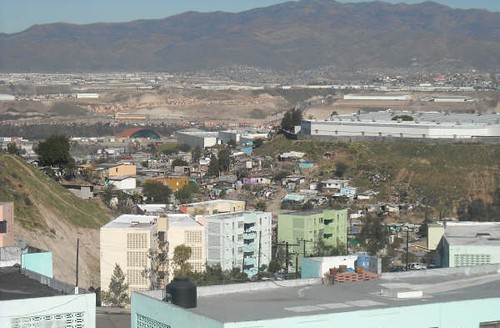
The term Sobre Ruedas means, literally, on wheels, it is a dynamic market that moves from neighborhood to neighborhood from one day to the next, it is in one location on Friday and another on Saturday, and so on. It is like a swap meet or a flea market, except that swap meets are static, and their existing has more to do with the desire of the small-scale seller than the needs of the remote buyer. The sobre ruedas exists primarily to bring the market to the remote neighborhoods, as the market provides the convenience of not having to travel miles and miles in order to buy goods. One or sometimes two times per week, a section of streets are closed or traffic is limited and a market is built for the day.

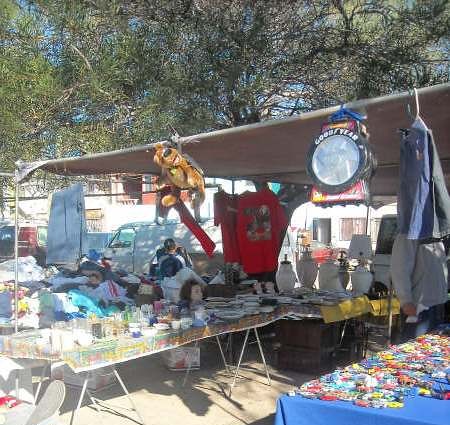
In remembering my first trip to the sobre ruedas, even before I lived here over seventeen years ago, it felt as though I could have been anywhere in Mexico, and the border could have been a thousand miles away. There were vendors of beef and chicken, manned with two people – one to sell the meat and the other to constantly swing around and keep the flies away. Sellers of produce were everywhere, some of whom sold off a bonus given to him from a long haul of mangoes or tomatoes or whatever he happened to be carrying from the fertile south. This is part of the true economy of Mexico, an economy that remains relatively untapped by a revenue-hungry government.
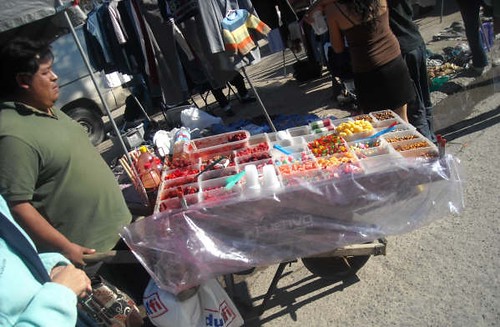
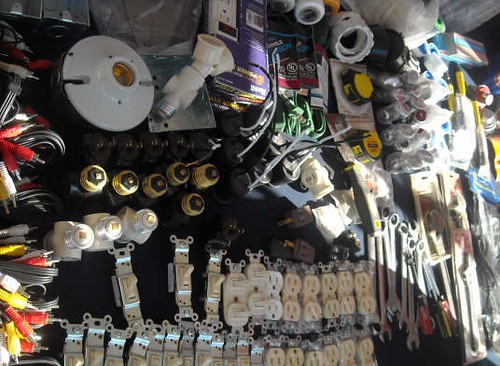

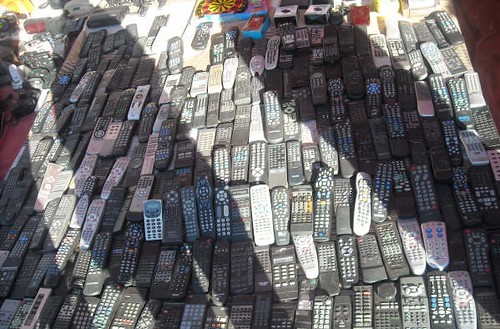
The cold weeks of the year, which are few, obviously limit the turnout at the sobre ruedas, but in the spring and deep into the summer, it feels festive and eventful. Neighbors, many of who don’t otherwise find the opportunity to exchange greetings, find each other strolling amongst the booths and they stop and chat for a while. Food is another attraction, featuring everything from pizza to churros and it is cooked on the spot. For anyone who can find it in a sobre ruedas, avocado ice cream is delicious in spite of sounding like an oddly flavored combination.
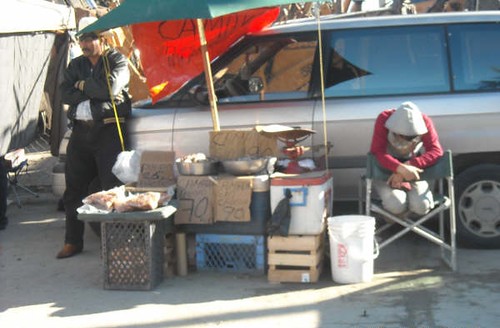


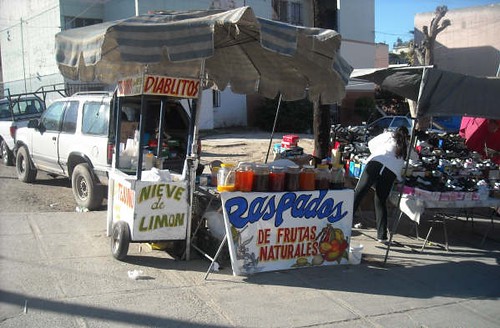
One great feature of the sobre ruedas, other than the atmosphere and the people and the jaw-dropping example of capitalism working at its most basic level, is the items that can sometimes be found there. Used cookware is a favorite target of mine; I own several cast iron skillets that were purchased for a couple of dollars each, which once retreated, have become indispensable. Oven-safe casserole dishes, serving platters, and other assorted kitchenware is among my cooking arsenal, and every so often I wander up the hill to see what else I can find. And the produce, which sports more varieties than one can find in any supermarket, is often of superior quality and usually less expensive than elsewhere.
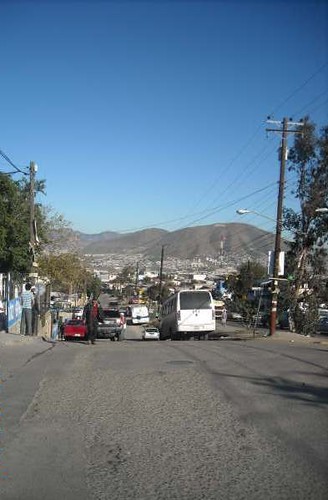

We sat in the Perico and drank in spite of the cold - it is likely the chilliest bar in Centro. This works very well in the summer but not so comfortably in the winter. The idea of moving to a warmer cantina never came up because there is no place cheaper to drink than the Perico. We sat and drank all afternoon until the sun went down, and I bought Scott at least three beers and Jody one, and I didn’t count how many times the tap filled my glass, maybe five or six times. I also splurged on a shot of tequila or two, and when I asked for my tab the total came to less than twenty dollars.
"The college isn’t renewing my position," Scott told me, some of his income was from teaching art at a college in San Diego part time.
"It’s the economy. The colleges are also feeling it," I said.
"I have to see if they’re going to extend my unemployment," he sighed.
"If they don’t, you can always go back to the occasional substitute teaching," I told him.
Scott doesn’t much care for babysitting high school students. I don’t blame him. But at least, there is that option. I walked Scott down Calle Sexta and dropped him off at the corner on his way to his apartment and I climbed into a route cab, we agreed to meet on Friday again. I thought about how the tourists never really get to see the real Tijuana, that maybe it would help the local economy if tourism could come to the sobre ruedas.
Then I thought about how maybe there could be a sort of sobre ruedas that consisted of tourists instead of markets, that busloads of tourists could be brought into Centro de Tijuana in the same way that the markets are brought to the remote neighborhoods of Tijuana. And then I drifted off to sleep right there in the cab for a half-hour and awoke just in time to exit at my stop. As I walked the long block home I thought about how lucky I was to be in a place where twelve miles and a nap only cost me eighty-five cents.
(All images courtesy of Anna M. Luna de Dodd)


0 Comments:
Post a Comment
Subscribe to Post Comments [Atom]
<< Home